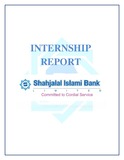Effect of liquidity risk on the profitability of Islamic banks listed in Dhaka Stock Exchange: a comparative study between Shahjalal Islami Bank Limited and other listed banks

View/Open
Date
2019-04Publisher
Brac UniversityAuthor
Rashid, Bushra BinteMetadata
Show full item recordAbstract
Banks are very crucial financial institutions of any economy. In their business cycle they face many ups and downs because of various systematic and unsystematic risks. One of the most important unsystematic risks is liquidity risk. From the year of 2017 after having excess liquidity for a certain time period, our country started facing liquidity crisis. Demand for loan from private sector is facing an upward trend. Both the conventional private commercial banks and Islami Shariah based private banks are in the list. This paper only focuses on Islami shariah based banks. Of eight Islamic banks, five had lent breaching the authorized ceiling of 90%. In this quarter, the loan to ratio surged upto 97% and the excess liquidity of this industry shrank to 19.54% in the 3rd quarter of 2018 because of aggressive investment. As a result Bangladesh Bank has reduced the loan to deposit ratio to 89%. So, liquidity crisis is rising. This report gives a glance to the relationship between liquidity risk and the profitability of Islami Shariah based banks listed in Dhaka Stock Exchange. It also includes a comparative study between Shahjalal Islami Bank Limited and other Islamic Banks. Moreover, some parts of the report give an overview of SJIBL as well as different division of the Motijheel Branch.
